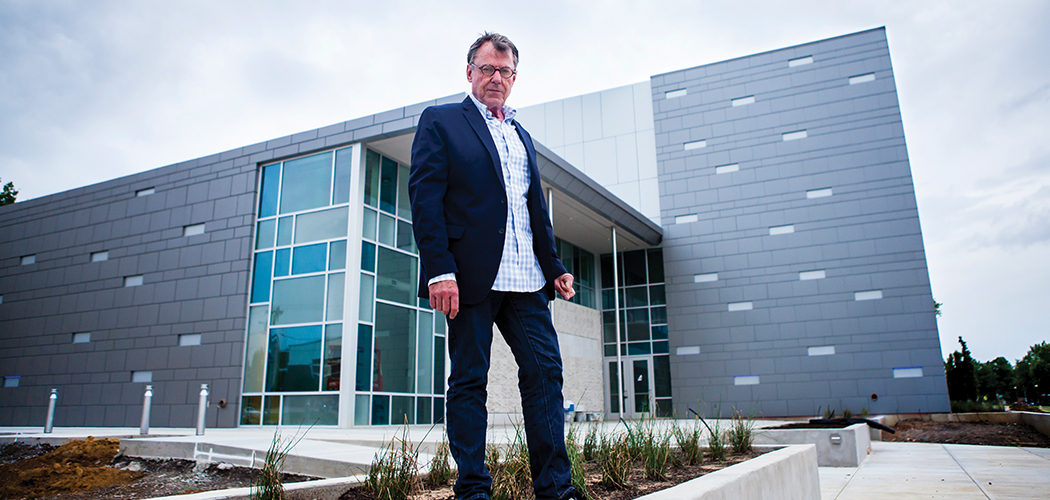[title subtitle=”words: Marcus Coker
Images: Rachel Putman (UA-Fort Smith)”][/title]
This month marks the completion of the Windgate Art and Design building at the University of Arkansas – Fort Smith. The newest addition to the campus, the three-story, 58,000-square-foot building will house both the graphic and studio art programs and provide a dedicated creative space for faculty, students, and the community.
The building, under construction for the last fourteen months, is located at the corner of Waldron Road and Kinkead Avenue and is significant because it brings under one roof a program that has been spread across campus for over forty years. “Up until now, we’ve been in four different areas,” says Don Lee, who’s seventy-one and head of the art department. “Nine classrooms in four different buildings. So the new place is going to be a learning curve. There will be a public space, a reception area, and two different art galleries—stuff we could only dream about before.”
For Don, who started teaching in 1972 when the university was Westark Community College, it’s been a long journey. He says, “We used to be in Quonset huts, buildings that came from Fort Chaffee. There were two little rooms with a partition, and I came in with a sledgehammer and knocked it down to create more space. One guy thought I’d be fired, like, if it’s not broke, don’t fix it. And I’m like, let’s break it. The dean asked why I didn’t do it sooner.”
Since 1975, Don and most of the art department classes have been in the Ballman-Speer building. Jessica Medeiros, who’s twenty-eight, a sophomore, and president of the Studio Art Coalition on campus, says, “Sometimes I paint in the lobby because we don’t have room in the classrooms. Our club meets in the lobby for the same reason. But the biggest challenge is not being with the other art students. It makes it difficult to collaborate.” Fortunately, the new space addresses all of these concerns.
Since 2008, the university has offered two four-year art degrees. All art students (which total about 180 at any given time) start with the same foundation classes (fifteen credit hours), then declare a major—either graphic art (Bachelor of Science) or studio art (Bachelor of Arts). In addition to housing both programs and all their classes, the Windgate building will also provide a space for certain journalism and humanity classes. Don says, “We are hoping it will change the face of the campus by providing a sense of unity and sharing visual arts across the disciplines.”
Talk of the new building started in 2012 after the art department hosted a visiting artist in Ballman-Speer. “The donors came to us and proposed the new building,” says Don. “I think they were impressed with the program, but took note of our limited space.”
The building is named for the Windgate Charitable Foundation of Siloam Springs, which donated $15.5 million in the form of a grant for the project, including research and planning, construction, and furnishing. The last $2.5 million is a matching grant, meaning it’s given as the university raises an additional $2.5 million that will be set aside as an endowment for the upkeep of both the building and the program.
WER Architects of Little Rock provided the plans for the building, which took about a year to finalize. Part of the planning process involved visiting a number of other universities and museums in order to gather ideas that would best serve the students in Fort Smith. “We tried really hard to let the building be a backdrop to the program,” says Eldon Bock, principal architect for the project. “It’s important for the students to take what they learn in the classroom outside the four walls, so one of the things we did was design the stairs in such a way that they doubled as a critique area, a space where students can share their work and lives with others.”
Built with energy efficiency in mind, the building takes the best advantage of natural lighting, uses LED lighting to reduce energy consumption, and uses many recycled materials for major building components. “Everyone put a lot of thought into things,” says Eldon. “Even the faculty decided to group their offices together, rather than by discipline, in order to encourage more collaboration.”
The contractor for the job was CDI Contractors, a company with offices in Little Rock and Fayetteville. Demolition on the site began in May 2014, and then construction of the building began. CDI employed about a hundred workers Monday through Friday and forty workers on Saturday, all working just under twelve-hour days, until the completion of the project.
Walking around the building in the weeks before it opens, Don points to a future classroom, empty except for concrete and dust. The ceilings are tall, and there are large glass windows that open up to the hallway. “We kept the classrooms open so you can see what’s going on. We’re ordering a lot of mid-century furniture, like Herman Miller. We’re designers, so we want contemporary things you can attach a name to. The environment should inspire creativity.”
To that end, there are multiple areas in the building for students to display and share their work. Also, there’s a theater room for viewing films, a first on campus. There’s a student-run art gallery on the second floor, and a professional art gallery on the first.
Don is clear that what they are doing, both in the program and the new building, makes a difference. “We’ve got former students working in studios in New York, one teaching painting at William and Mary. We’re creative and we’re problem solvers, and we create a demand because we are willing to make things work. But creativity isn’t limited to artists. Writers start with an idea, make an outline, revise it. That’s creativity. And if you can be creative in one area, you can transpose it to another. Students go from English to art class and don’t always see how they connect.”
As part of helping students transition from the classroom to the “real world,” the Windgate building features a room designed to imitate an ad agency, a place where graphic design students can use and
apply their learning before finding a job and going to work.
“Our mission is to develop the skills in students to be ready for employment, and I think this building is going to do that very well,” says John Post, director of public information at the university. “It’s beautifully created—a true centerpiece for the campus—and will no doubt help with recruiting both future students and faculty.”
“We’re working on the ‘build it and they will come’ idea,” says Don.
A year and a half ago, another building stood where the Windgate building is now. It was once a gas station, then a bookstore, then the Center for Lifelong Learning. But just like Don took a sledgehammer to the wall of the Quonset hut over forty years ago, the construction workers tore that building down in order to make space for something new. And perhaps that’s the true job of the artist, to see something no one else sees, and then to make it. And surely we all benefit from both the spaces that artists create, and the artists created within those spaces.
There will be a ribbon cutting ceremony for the building on Thursday, September 3. For details, check uafs.edu or call 479.788.7021. The foundation is still raising funds for the $2.5 million endowment. Additionally, they are accepting donations in the form of art and furniture for the building. If interested in donating, contact: Dr. Mary Bane Lackie, Vice Chancellor for University Advancement/Executive Director, UAFS Foundation
mary.lackie@uafs.edu | 479.788.7021




